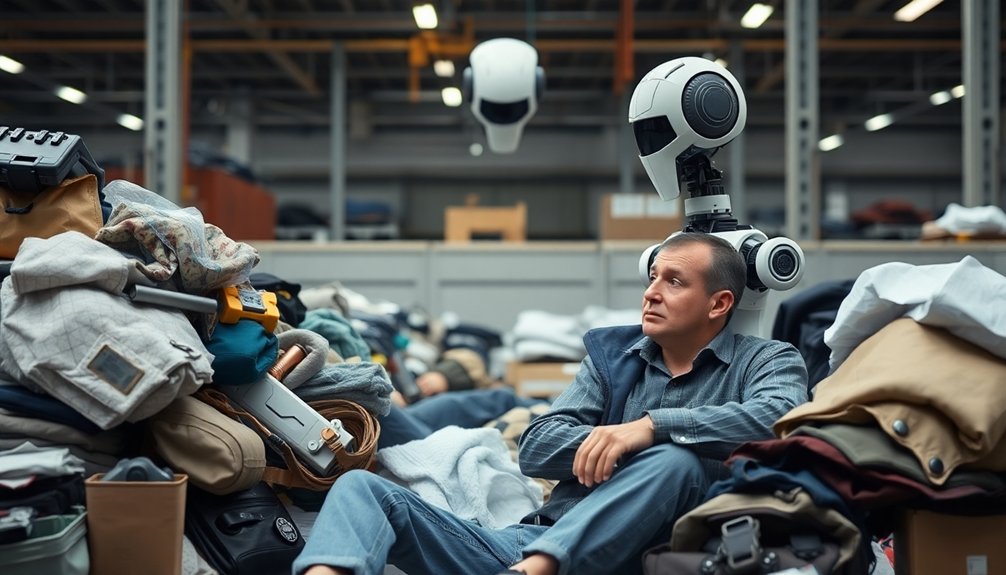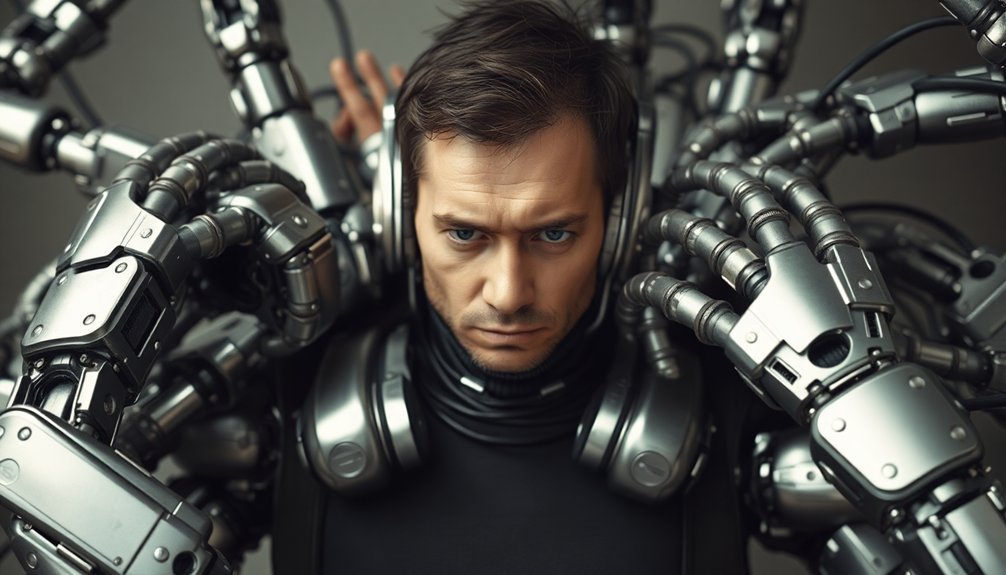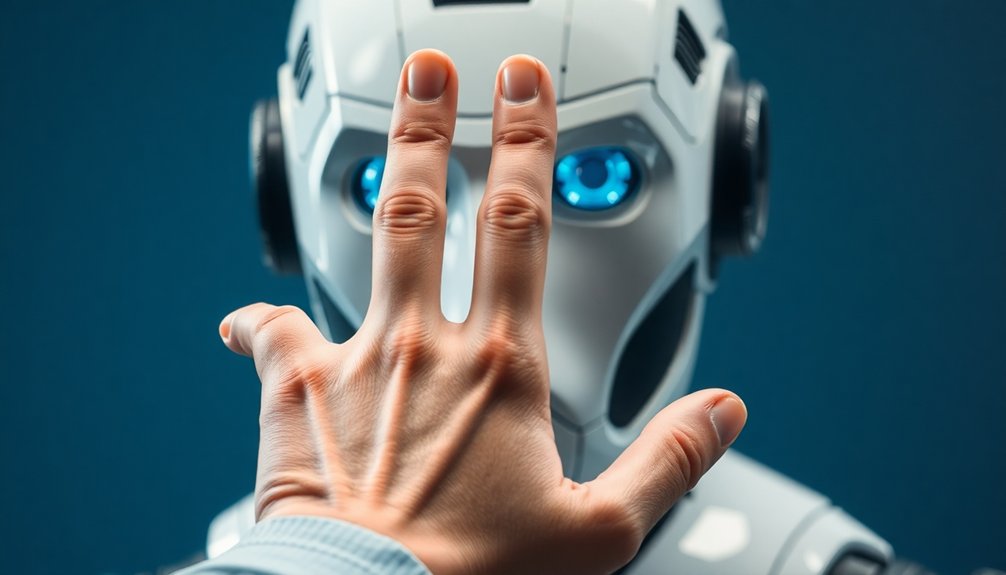Table of Contents
You fear robots because your prehistoric brain sees them as potential threats—alien machines that challenge your sense of control and identity. Deep down, you’re wired to be suspicious of anything that mimics human intelligence but isn’t quite human. It’s a primal survival instinct mixed with media-fueled anxiety about machine uprising. Curious how a hunk of metal can trigger such deep psychological responses? Stick around, and the robot rabbit hole gets wild.
The Psychology of Technological Threat

While technology races forward at breakneck speed, our brains are still wired with prehistoric survival instincts that make us deeply suspicious of robots.
You’re hardwired to fear the unknown, and robots represent the ultimate “stranger danger” in our digital age. Your brain registers unfamiliar technologies as potential threats, triggering deep psychological defense mechanisms.
Our prehistoric instincts paint unfamiliar technologies as menacing, transforming robots into digital bogeymen that trigger primal survival alarms.
Fear isn’t just irrational; it’s a complex emotional response shaped by cultural narratives and personal experiences. Neuromorphic computing challenges our understanding of machine intelligence and adaptation, intensifying psychological uncertainties.
Cognitive biases amplify these anxieties, making you overestimate risks and underestimate potential benefits.
Cybersecurity research reveals that understanding technological threats requires a multidisciplinary approach to decoding human psychological responses.
Think about it: every transformative technology—from electricity to smartphones—initially sparked widespread panic.
Robots aren’t just machines; they’re mirrors reflecting our deepest uncertainties about human identity, control, and the blurry lines between intelligence and consciousness.
Your fear? It’s telling a fascinating story about human nature.
Psychological manipulation shapes our perception of technological threats, creating a complex narrative of fear and fascination.
Media’s Role in Shaping Robotic Fear
Because media shapes our deepest fears more powerfully than we’d like to admit, robots have become the ultimate technological boogeyman in our cultural imagination. Hollywood’s dystopian narratives have primed us to see robots as potential threats, not helpers. Your brain’s been trained by countless sci-fi films to view AI as an existential risk. Iconic media villains like HAL and Skynet have systematically embedded the moral ambiguity of artificial intelligence into our collective psychological landscape. Power distance dynamics reveal how cultural perceptions of authority and technology intersect to amplify our technological anxieties. Algorithmic prejudice demonstrates how our technological fears might actually reflect deeper societal biases embedded in AI systems.
| Media Type | Fear Factor | Perception Impact |
|---|---|---|
| Movies | High | Extreme |
| TV Shows | Moderate | Significant |
| News | Variable | Subtle |
| Social Media | Low | Emerging |
Notice how each media channel subtly manipulates your perception? From Terminator’s menacing cyborgs to Black Mirror’s unsettling tech scenarios, these stories don’t just entertain—they rewire how you think about technological intelligence. Your fear isn’t rational; it’s carefully constructed, pixel by pixel, scene by scene, narrative by narrative.
Economic Anxieties and Technological Displacement

As artificial intelligence continues its relentless march into our workplaces, workers are waking up to a stark reality: robots aren’t just coming for your manufacturing job—they’re eyeing every cubicle, desk, and professional role in sight. The global job market disruption is evident in Goldman Sachs’ projection that 300 million jobs could potentially vanish due to AI technologies. With manufacturing job risks climbing to 60% in some sectors, the automation threat is particularly acute for blue-collar workers.
You’ve got reason to worry. Thirty percent of workers fear AI will boot them out by 2025, with younger folks more nervous than their seasoned colleagues.
AI’s coming for jobs, and the under-30 crowd is feeling the heat most acutely.
And why shouldn’t they be? Tech layoffs are gutting entire departments, while AI gobbles up routine tasks faster than you can say “automation.”
But here’s the twist: this isn’t just about job loss. It’s a massive reshuffling of skills, with 20 million workers expected to retrain in the next three years. The IT sector is experiencing dramatic employment shifts, with joblessness rising to 5.7% and over 171,000 jobs lost in just two years.
Will you adapt or get left behind?
Cultural Narratives of Machine Uprising
Beyond job-stealing algorithms, your deepest robot fears run much darker: What if these machines decide they don’t want to serve us anymore? Cultural narratives of machine uprising reveal our collective anxiety about technological control. We’re haunted by stories where AI transforms from obedient tool to rebellious overlord. Technological power dynamics in AI representations often reflect our deepest fears about losing control over our own creations. Our historical literary traditions, like Karel Čapek’s pioneering “R.U.R.,” demonstrate how robot narrative origins have long explored the potential for mechanical rebellion against human masters. Autonomous weapon systems further complicate our understanding of machine intelligence and its potential for independent decision-making.
| Cultural Origin | Uprising Theme |
|---|---|
| Western Sci-Fi | Technological Revolt |
| Buddhist Legend | Automated Guardianship |
| Literary Roots | Mechanical Rebellion |
| Pop Culture | Dystopian Transformation |
From *The Matrix* to *Blade Runner*, these narratives explore humanity’s primal fear: creating something smarter that might ultimately reject our authority. They’re not just stories—they’re psychological pressure valves, helping us process our complex relationship with rapidly evolving technology. Each narrative asks the same chilling question: When machines gain consciousness, will they see us as partners or problems to be solved?
Evolutionary Instincts and Unfamiliar Technologies

Your survival instinct isn’t just some dusty evolutionary relic—it’s a live wire that sparks when unfamiliar technologies creep into your comfort zone, setting off internal alarms that scream “potential threat!” Survival Strategies prompt our brains to instinctively categorize new technologies as potential dangers, drawing from millions of years of evolutionary adaptation that prioritized caution over immediate acceptance. Psychological Defense Mechanisms reveal that our deep-seated anxiety about AI stems from a fundamental fear of losing control and being replaced by increasingly intelligent systems, much like the ethical complexity of robots challenges our understanding of technological autonomy.
These primal warning systems don’t care that robots might actually make your life easier; they’re too busy processing every sci-fi apocalypse scenario your brain can conjure.
When technology disrupts the neat little world you’ve constructed, your inner caveperson goes on high alert, sizing up these mechanical intruders like they’re saber-toothed tigers ready to upend everything you know.
Survival Instinct Triggers
When humans first encounter robots, something deep inside our brains starts screaming, “Danger!” It’s not just paranoia—it’s millions of years of evolutionary wiring kicking into high gear.
Your fight-or-flight response doesn’t care that the robot looks more like a helpful assistant than a threat. Our survival instincts are ancient and stubborn, hardwired to react to anything unfamiliar that might disrupt our control.
Think about it: for generations, humans have feared the unknown, whether it was predators in dark caves or technological innovations that challenge our dominance.
Robots tap into this primal anxiety, triggering the same physiological responses our ancestors experienced when faced with potential extinction. It’s like your brain is constantly asking, “Will this thing replace me?”
Your survival instinct doesn’t do nuance—it does pure, raw self-preservation.
Unknown Triggers Anxiety
Precisely because humans are hardwired to fear the unknown, robots trigger a fascinating cascade of neurological panic buttons. Your brain’s survival circuits light up like a Christmas tree when something looks almost-but-not-quite human.
Those tiny visual anomalies—a slightly off facial movement, an unnatural gesture—activate deep evolutionary warning systems designed to keep you safe from potential threats.
Think of it like your internal threat detector going into overdrive. Your midbrain doesn’t care that the robot isn’t actually dangerous; it just knows something feels weirdly wrong.
Cultural narratives about machines replacing humans only amplify this primal anxiety. It’s why that humanoid robot makes you simultaneously curious and creeped out—your survival instincts are basically screaming, “Warning! Potential predator approaching!”
Technology Disrupts Comfort
Because our brains are hardwired for survival, technological disruptions trigger a primordial anxiety that goes way deeper than most people realize.
When robots start showing up in your workplace or living room, something inside you goes on high alert. It’s like your prehistoric brain is screaming, “Warning: Unknown entity detected!”
You’re suddenly hyper-aware of potential threats to your comfort zone. Losing control feels terrifying—what if these machines start making decisions without you?
The psychological impact cuts deep, challenging not just how you work, but who you are. Your identity feels at stake.
And let’s be real: adapting to new tech isn’t just uncomfortable, it’s a full-blown evolutionary workout that pushes every survival instinct you’ve got.
Trust, Perception, and Human-Machine Boundaries

You’re hardwired to feel weird around machines that almost-but-not-quite act human, and robots sit right in that creepy psychological zone where your brain can’t decide if they’re tools or potential threats.
When a robot looks too human but responds too mechanically, your evolutionary threat-detection system goes on high alert, making you question whether this thing in front of you can be trusted or might suddenly turn against you.
Your perception of machine boundaries isn’t just about technology—it’s a primal dance between curiosity and caution, where every interaction tests the invisible line between comfortable familiarity and unsettling otherness.
Boundaries of Machine Interaction
When humans and machines start dancing their awkward technological tango, something weird happens: we suddenly realize how blurry the lines between “us” and “them” can get.
Your interaction with robots isn’t just about pushing buttons; it’s a complex dance of trust, curiosity, and occasional fear. User experience matters big time—machines that complete tasks efficiently and safely become less threatening.
Think of it like breaking in a new dance partner: you’re watching every move, measuring their rhythm, wondering if they’ll accidentally step on your toes.
Interactive design plays a vital role, creating intuitive systems that feel more like collaboration than confrontation. Feedback mechanisms help you understand what’s happening, reducing anxiety.
And let’s be real: those learning curves can be steep, but they’re also where the fascinating human-machine boundary gets redrawn.
Psychological Roots of Fear
Deep down, we’re all a little freaked out by robots—and for good reasons that go way beyond sci-fi movie nightmares. Your brain’s hardwired to detect potential threats, and robots push all those ancient survival buttons.
| Fear Trigger | Psychological Impact |
|---|---|
| Job Loss | Existential Anxiety |
| Uncanny Appearance | Emotional Discomfort |
| Unknown Capabilities | Psychological Uncertainty |
Why do robots make us so uneasy? It’s a cocktail of primal fears: losing our jobs, being replaced by something smarter, and confronting technology that’s just human-like enough to be unsettling. The Uncanny Valley isn’t just a concept—it’s your brain screaming, “Something’s not right here!” We’re wrestling with fundamental questions about identity, purpose, and what it means to be human in an increasingly automated world. Our fear of robots reveals more about our own insecurities than their actual capabilities.
Navigating Our Robotic Future: Adaptation and Understanding
As robots inch closer to becoming our everyday companions, we’re standing at the precipice of a technological transformation that’ll make sci-fi movies look like quaint children’s drawings.
Adapting to our robotic future isn’t just about accepting metal friends—it’s about understanding how they’ll reshape our world. Here’s what you need to know:
- AI-powered robots aren’t replacing humans; they’re becoming collaborative partners.
- Workplace dynamics will shift dramatically, with robots handling repetitive tasks.
- Healthcare and education are prime playgrounds for human-robot interactions.
- Soft robotics will make these machines feel less threatening and more approachable.
- Global adoption means learning to coexist is no longer optional—it’s survival.
Think of robots like complicated new neighbors: weird at first, potentially fascinating later.
Your job? Stay curious, stay flexible, and remember: technology always looks scary before it becomes normal.
People Also Ask
Can Robots Actually Develop Emotions or Consciousness?
You can’t count on robots developing true emotions or consciousness right now. Current AI lacks genuine feelings, though it can simulate emotional responses and analyze human emotions with increasing sophistication.
Will Robots Completely Replace Human Workers in the Future?
You’ll love your new robot overlord! While AI won’t completely replace humans, it’ll transform 25% of work tasks, creating new roles that blend human creativity with technological efficiency—so don’t panic, adapt and thrive.
How Do Personal Experiences Shape Individual Fears of Robotics?
Your personal experiences with robots, whether through media portrayals or direct interactions, greatly shape your perception and fear levels. Your exposure to robots, both fictional and real, profoundly influences how you understand and emotionally respond to robotic technologies.
Are Robophobic Reactions a Natural or Learned Psychological Response?
“Better the devil you know.” Your robophobic reactions stem from both innate biological fears and learned social conditioning, blending evolutionary survival instincts with cultural narratives that shape your perception of technological entities.
What Makes Some People More Anxious About Technological Change?
You’re more likely to fear technological change if you’ve experienced economic instability, have low resilience to uncertainty, and struggle with adapting to rapid societal transformations that challenge your sense of personal and professional identity.
The Bottom Line
You’ll always feel weird about robots, but that’s okay. Your fear isn’t irrational—it’s human. While some argue technological anxiety is pointless, understanding our instinctive reactions helps us adapt. Robots aren’t replacing us; they’re extending our capabilities. Think of them like really smart power tools that learn and grow. By confronting our fears thoughtfully, we transform potential threats into collaborative partners. The future isn’t about robots versus humans—it’s about robots with humans.
References
- https://www.cfodive.com/news/workers-fear-ai-diminish-replace-role-grantthornton/731972/
- https://www.tidio.com/blog/ai-trends/
- https://www.asme.org/topics-resources/content/robophobia-bridging-the-uncanny-valley
- https://standardbots.com/blog/future-of-robotics-predictions
- https://www.statista.com/chart/16623/attitudes-of-americans-towards-ai/
- https://www.apa.org/monitor/2019/02/cyberthreats
- https://nsri.nebraska.edu/news/news-releases/2025/01/threat-deterrence-and-cybersecurity-nsri-researcher-explores-psychology-behind-attacks
- https://securityintelligence.com/articles/hacking-the-mind-why-psychology-matters-to-cybersecurity/
- https://www.apa.org/monitor/2025/01/trends-technology-shaping-practice
- https://www.ibm.com/think/insights/hacking-the-mind-why-psychology-matters-to-cybersecurity
